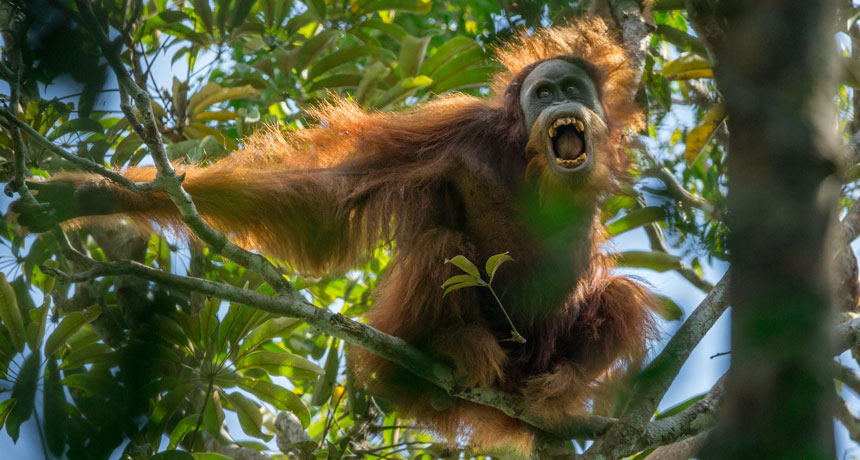No more than 800 orangutans from this newly identified species remain

Orangutans living in forested foothills on the Indonesian island of Sumatra represent a previously unknown species, researchers say.
Skeletal and genetic evidence puts these apes on a separate evolutionary trajectory from other orangutans in Sumatra (Pongo abelii) and Bornean orangutans (Pongo pygmaeus), says a team led by evolutionary anthropologist Michael Krützen of the University of Zurich. The researchers named the new species Pongo tapanuliensis, or the Tapanuli orangutan. Krützen’s team reports its findings online November 2 in Current Biology.
The name P. tapanuliensis refers to three north Sumatran districts — North, Central and South Tapanuli — where no more than 800 of these orangutans inhabit several forested areas. Tapanuli orangutans live on the brink of extinction due to road construction, illegal forest clearing and killings by villagers and hunters, the scientists say. Estimates vary, but the World Wildlife Fund puts the total number of living orangutans at nearly 120,000.
Researchers observed Tapanuli orangutans in their hilly habitat as early as the 1930s. Yet these apes have long been overlooked in favor of Sumatran orangutans that live in swampy forests north of the Tapanuli population. Bornean orangutans also live in swampy forests.
A chance to explore Tapanuli orangutans’ biology came in 2013. Krützen’s team gained permission to study the museum-held skeleton of an adult male Tapanuli orangutan that had been killed by villagers. Comparisons with skeletons of 33 Sumatran and Bornean male orangutans revealed a range of differences in the skull and teeth of the Tapanuli ape, including a distinctively narrow palate and a relatively short jaw joint.
An analysis of DNA from 37 living orangutans, including two Tapanuli animals, indicated that Tapanuli and Sumatran orangutans diverged from a common ancestor around 3.4 million years ago. Shared gene variants pointed to interbreeding between the two species after their evolutionary split. Cross-species hookups declined sharply around 100,000 years ago and then stopped between 10,000 and 20,000 years ago, the scientists say. Sumatran and Bornean orangutans separated around 674,000 years ago, the team estimates.
Only Tapanuli orangutans appear to be direct descendants of the first mainland Asian orangutan ancestors to reach Sumatra, the investigators find. Later migrations of mainland animals may have led to the evolution of Sumatran and Bornean orangutans
Scenarios in which closely related ape species interbred after evolving into distinctive biological populations probably occurred frequently, Krützen says. DNA studies suggest ancient chimpanzees and bonobos interbred, as did Homo sapiens and Neandertals (SN: 10/15/16, p. 22). Such evidence has fueled a long-standing debate over how to define the term “species” (SN: 11/11/17, p. 22).
Krützen’s team makes a good case for a third orangutan species that interbred for a long time with a closely related species, says biological anthropologist Rebecca Ackermann of the University of Cape Town in South Africa. “I’d go out on a limb and say not only that [interbreeding] played an important role in the evolution of all living apes, but that it shaped the evolution of extinct ones as well.”